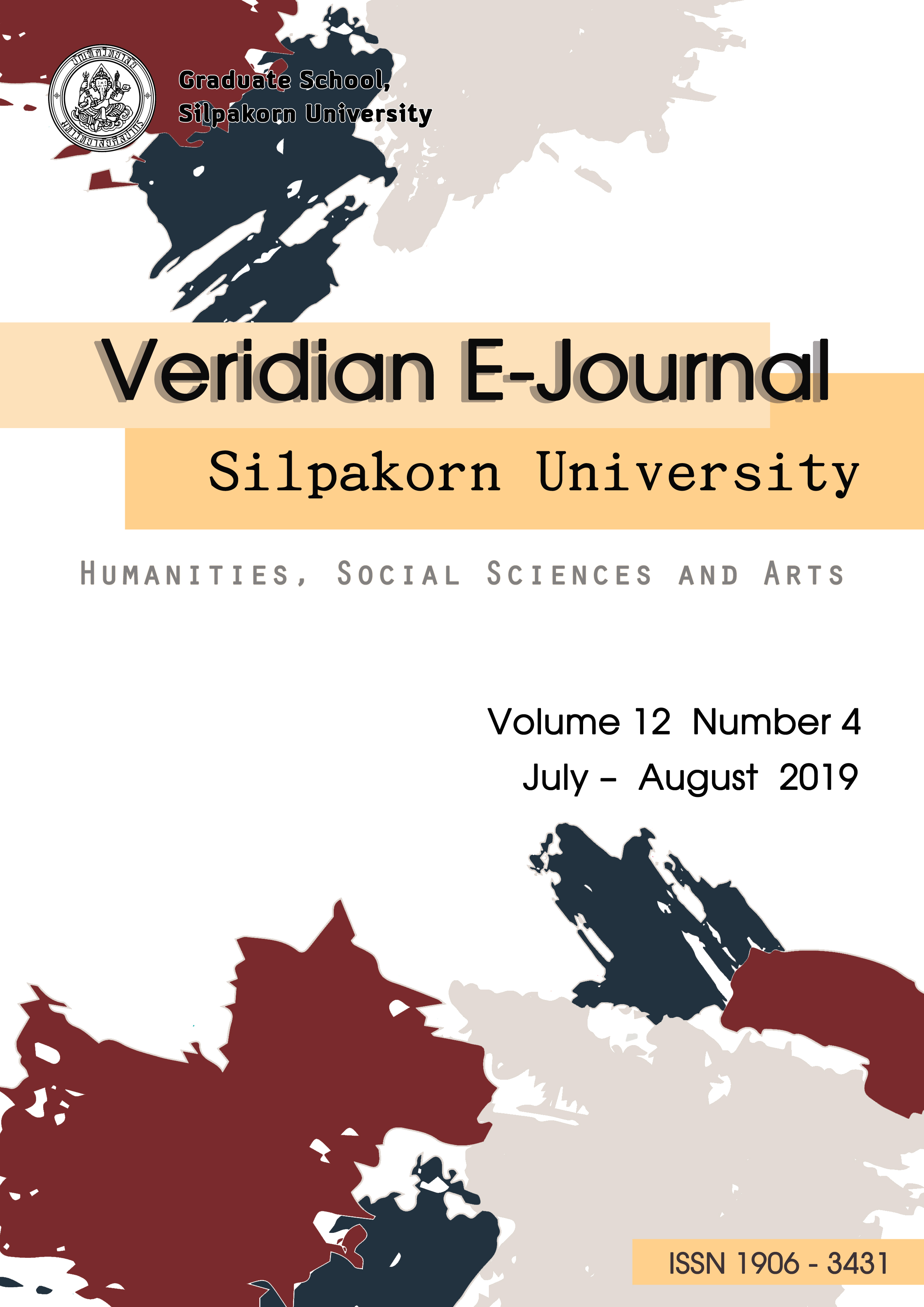การพัฒนาหลักสูตรศิลปศึกษาโดยใช้สถานที่เป็นฐานเพื่อสร้างนวัตกรรม ศิลปวัฒนธรรมชุมชนชานเมือง (Development of Place-Based Art Education Curriculum to Create Suburban Community Artistic and Cultural Innovations )
Main Article Content
Abstract
การศึกษาครั้งนี้มีวัตถุประสงค์เพื่อพัฒนาหลักสูตรศิลปศึกษาโดยใช้สถานที่เป็นฐานเพื่อสร้างนวัตกรรมศิลปวัฒนธรรมชุมชนชานเมืองโดยใช้รูปแบบการวิจัยและพัฒนา (Research and Development)สำหรับระยะที่ 1 – 2 ใช้ระเบียบวิธีวิจัยเชิงคุณภาพด้วยการศึกษาเอกสารและการสัมภาษณ์เชิงลึกกับผู้เชี่ยวชาญ จำนวน 18 คน และทำการศึกษาผู้เรียนจำนวน 15 คนเครื่องมือที่ใช้ในการวิจัย ประกอบด้วย 1. แบบสัมภาษณ์กึ่งมีโครงสร้าง 2.เครื่องมือวิธีวิจัยทางมานุษยวิทยาทางการรับรู้ (Cognitive Anthropology) ได้แก่ เทคนิค Pile sorting เทคนิค Pictorial ethnography และการสัมภาษณ์แบบไม่เป็นทางการกับกรณีศึกษา (Informal interview) วิเคราะห์ข้อมูลด้วยวิธีวิเคราะห์เนื้อหา (content analysis)และตรวจสอบความตรงของหลักสูตรการเรียนรู้โดยผู้เชี่ยวชาญ 5 คน โดยใช้ค่าดัชนีความสอดคล้อง (Item – Objective Congruence = IOC)
จากการศึกษาพบว่า องค์ประกอบของหลักสูตร ประกอบด้วย 1) แนวคิดของหลักสูตร 2) วัตถุประสงค์ 3) สาระการเรียนรู้ ได้แก่ ศิลปวัฒนธรรมชุมชน ภูมิปัญญาท้องถิ่น การสร้างนวัตกรรม และสื่อสร้างสรรค์เพื่อต่อยอดเชิงพาณิชย์ 4) การจัดการเรียนรู้โดยใช้สถานที่เป็นฐานมีองค์ประกอบดังนี้ 4.1) การเชื่อมโยงผู้เรียนกับท้องถิ่นของตน 4.2) การค้นคว้าเกี่ยวกับท้องถิ่น 4.3) การค้นคว้าแบบองค์รวม 4.4) การมีส่วนร่วมในท้องถิ่น 5) กระบวนการพัฒนานวัตกรรมศิลปวัฒนธรรมชุมชน โดยใช้แนวคิดการออกแบบ Design Thinking และกระบวนการคิดสร้างสรรค์แบบ Synectics มี 7 ขั้นตอน ดังนี้ 5.1) ศึกษาข้อมูลเกี่ยวกับศิลปวัฒนธรรมและภูมิปัญญา 5.2) วิเคราะห์สภาพปัญหาและความต้องการ 5.3) ออกแบบนวัตกรรม 5.3.1) ขั้นสร้างแรงบันดาลใจ 5.3.2) ขั้นเทคนิคที่สนใจ 5.3.3) ขั้นประโยชน์ที่คาดว่าจะได้รับ 5.3.4) ขั้นออกแบบแบบ Synectics 5.4) สร้างหรือพัฒนานวัตกรรม 5.5) ทดลองใช้นวัตกรรม 5.7) สรุปรายงาน และเผยแพร่ 6) สื่อและแหล่งเรียนรู้ 7) การประเมินผล 8) การสะท้อนคิด และ 9) ลักษณะผู้เรียน
This study aims to development of Art Education Curriculum by using Place – Based Education to create suburban community artistic and cultural innovation. The elements of the courses are presented by using the research and development model. Thephase 1 – 2 of the research, qualitative research methodology was used by studying documents. In-depth interviews technique with 18 experts and 15 learners was used in the second phase of this research. The instrument used in this research consisted of 1. Semi-structured interview 2. Research methods in cognitive anthropology techniques including Pile sorting technique, Pictorial ethnography technique and informal interview with case studies (Informal interview). The data was analyzed by using content analysis. The validity of the learning program was examined by 5 experts using the index Looped (Item - Objective Congruence = IOC).
The study found the components of the curriculum consist of: 1) Concepts of the curriculum 2) Objectives 3) Learning materials include art, culture and community local knowledge Innovation and creative media for further commercialization 4) Learning management by using the location of the base has the following elements: 4.1) Linking learners with their locality 4.2) Local research 4.3) Holistic research 4.4) Contribution Join in the local 5) Community and cultural innovation development process by using the design thinking concept and the synectics creativity process. There are 7 steps as follows 5.1) Study information about arts, culture and wisdom 5.2) Analyze conditions, problems and needs 5.3) Innovative designs 5.3.1) Inspirational steps 5.3.2) Interesting technical steps 5.3.3) Expected benefits Receiving 5.3.4) Synectics design stage 5.4) Creating or developing innovation 5.5) Using innovation 5.7) Summary of reports and releases. 6) Media and learning resources 7) Evaluation 8) Reflection and 9) Student characteristics.

